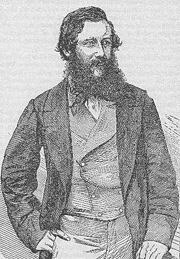By Bernard Verdcourt
 During the famous journey of 1858 which resulted in the first European sighting of Lake Tanganyika by Sir Richard Francis Burton (1821-1890), his companion, Capt. J.H. Speke (1827—64), collected a few shells on its shores. One of the most fascinating problems of East African conchology was thus made known before almost any of the more ordinary molluscs of the area had been described. These found their way back to the British Museum where S.D. Woodward (1821-1863) remarked on their curious marine appearance. The incredible arguments which were to fill hundreds of articles and several books were soon to begin. Was Lake Tanganyika an inland Jurassic sea cut off and isolated with subsequent freshening of the water? E.A. Smith, when describing more shells from the lake in 188i, drew attention to the possibility. The subsequent discovery of a jelly-fish in the lake by Dr. Böhm seemed to clinch the matter. Later of course, freshwater jelly—fish were found in other lakes and rivers, and different theories (which I touched on in my first Presidential address) came to prevail. Woodward’s early perspicacious placing of the shells in the Melaniidae is now known to be correct.
During the famous journey of 1858 which resulted in the first European sighting of Lake Tanganyika by Sir Richard Francis Burton (1821-1890), his companion, Capt. J.H. Speke (1827—64), collected a few shells on its shores. One of the most fascinating problems of East African conchology was thus made known before almost any of the more ordinary molluscs of the area had been described. These found their way back to the British Museum where S.D. Woodward (1821-1863) remarked on their curious marine appearance. The incredible arguments which were to fill hundreds of articles and several books were soon to begin. Was Lake Tanganyika an inland Jurassic sea cut off and isolated with subsequent freshening of the water? E.A. Smith, when describing more shells from the lake in 188i, drew attention to the possibility. The subsequent discovery of a jelly-fish in the lake by Dr. Böhm seemed to clinch the matter. Later of course, freshwater jelly—fish were found in other lakes and rivers, and different theories (which I touched on in my first Presidential address) came to prevail. Woodward’s early perspicacious placing of the shells in the Melaniidae is now known to be correct.Later Speke made the famous journey accompanied by Capt. J.A. Grant (1827-1892) during which the first collections of dried plants were brought back from the interior of East Africa and one of the sources of the Nile found; that perennial problem which had vexed men since antiquity (though I suspect some ancient Egyptians probably penetrated far south), was at least partially solved. Volumes have been written about Burton and Speke, two men so different in character that it is difficult to see how they could have tolerated each other for a moment. Burton was a romantic arabist who spoke some thirty languages, had translated the Arabian Nights and more recondite erotica, a strange mixture of fastidious scholar and debauched libertine, but one of the best informed and scholarly of Victorian explorers. Speke was a more conventional respectable young Victorian. About all they had in common was toughness and a remarkable facility for learning languages.
Those who wish to read more about this fascinating pair will find an excellent account in Alan Moorehead’s ‘The White Nile’. Some very revealing remarks made by Speke about Burton in some of his letters to others are mentioned in an auction catalogue for the sale of J.A. Grant’s papers which is well worth reading (see beneath). Speke and Burton were to have wordy battles later in England and even now no one is quite certain that Speke’s death was due to "accidental discharge of his own gun", the verdict returned by the coroner’s jury – the faint possibility that he committed suicide just before he had agreed to meet and argue with Burton on a public platform is perennially suggested and, if true, very sad because Speke was right and Burton wrong over the fact that Lake Victoria was a source of the Nile.
List of molluscs described from material collected by J. H. Speke
| Iridina (Pleiodon) spekii | Woodward, 1859. | Tanzania, Lake Tanganyika. | = Pleiodon (Cameronia) spekii (Woodward, 1859). Holotype in BM 1859.12.23.8 |
| Lithoglyphus zonatus | Woodward, 1859. | Tanzania, Lake Tanganyika. | = Spekia zonata (Woodward, 1859). Syntypes in BM 1859.12.23.10 (two specimens, one marked with black dot by Connolly? selected as lectotype). |
| Melania (Melanella) nassa | Woodward, 1859. | Tanzania, Lake Tanganyika. | = Lavigeria nassa (Woodward, 1859). Syntypes in BM 1859.12.23.11 (two specimens, one not marked with black dot selected as lectotype). |
| Unio burtoni | Woodward, 1859. | Tanzania, Lake Tanganyika. | = Grandidieria burtoni (Woodward, 1859). Holotype in BM 1859.12.23.9 (also figured by Sowerby, 1866, Conch. Icon. 16 Unio species 251, pl. 47, fig 251). |
References
B. Verdcourt
